小学英语研究性学习成果评价量规模板
- 格式:xls
- 大小:525.00 KB
- 文档页数:2
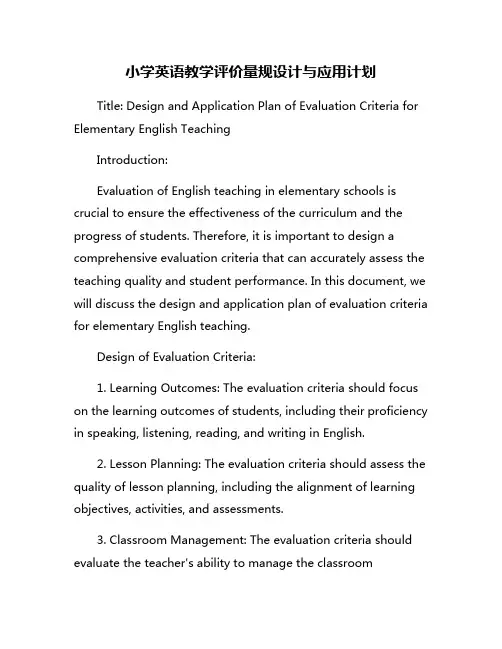
小学英语教学评价量规设计与应用计划Title: Design and Application Plan of Evaluation Criteria for Elementary English TeachingIntroduction:Evaluation of English teaching in elementary schools is crucial to ensure the effectiveness of the curriculum and the progress of students. Therefore, it is important to design a comprehensive evaluation criteria that can accurately assess the teaching quality and student performance. In this document, we will discuss the design and application plan of evaluation criteria for elementary English teaching.Design of Evaluation Criteria:1. Learning Outcomes: The evaluation criteria should focus on the learning outcomes of students, including their proficiency in speaking, listening, reading, and writing in English.2. Lesson Planning: The evaluation criteria should assess the quality of lesson planning, including the alignment of learning objectives, activities, and assessments.3. Classroom Management: The evaluation criteria should evaluate the teacher's ability to manage the classroomeffectively, engage students in learning, and create a positive learning environment.4. Assessment Methods: The evaluation criteria should assess the effectiveness of assessment methods used by teachers to measure student learning and progress.5. Professional Development: The evaluation criteria should consider the professional development of teachers, including their knowledge of English language teaching methodologies and strategies.Application Plan:1. Observations: Conduct regular classroom observations to evaluate the teaching quality and student engagement. Provide constructive feedback to teachers based on the observations.2. Student Assessments: Use a variety of assessment methods to evaluate student learning outcomes, such as quizzes, tests, projects, and presentations. Analyze the results to identify areas for improvement.3. Teacher Training: Provide professional development opportunities for teachers to improve their English language teaching skills. Offer workshops, seminars, and online courses on effective teaching strategies.4. Parental Involvement: Involve parents in the evaluation process by soliciting feedback on their child's progress in English learning. Communicate regularly with parents to discuss student performance and address any concerns.5. Data Analysis: Collect and analyze data on student performance, teacher evaluations, and other relevant metrics to assess the effectiveness of the English teaching program. Use this data to make informed decisions for improvement.Conclusion:By designing and implementing a comprehensive evaluation criteria for elementary English teaching, schools can ensure the quality of education provided to students and support the professional development of teachers. Regular assessment and feedback are essential for continuous improvement and the achievement of learning goals.共Overall, the design and application plan of evaluation criteria for elementary English teaching is essential for promoting student learning and teacher effectiveness. By focusing on learning outcomes, lesson planning, classroom management, assessment methods, and professional development, schools can achieve excellence in English language education.。
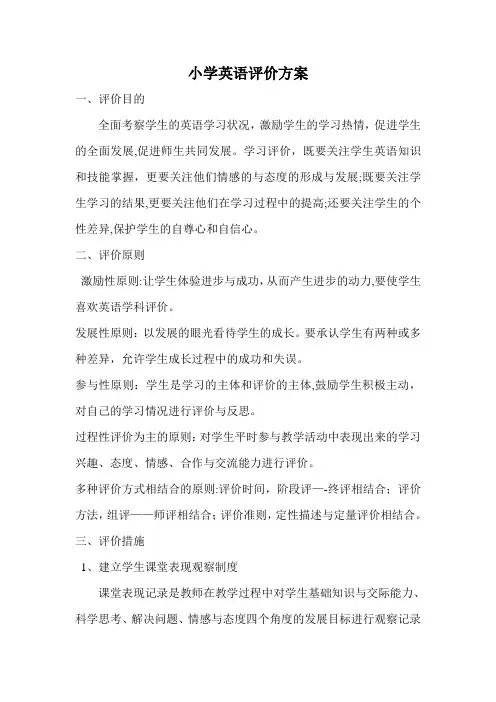
小学英语评价方案一、评价目的全面考察学生的英语学习状况,激励学生的学习热情,促进学生的全面发展,促进师生共同发展。
学习评价,既要关注学生英语知识和技能掌握,更要关注他们情感的与态度的形成与发展;既要关注学生学习的结果,更要关注他们在学习过程中的提高;还要关注学生的个性差异,保护学生的自尊心和自信心。
二、评价原则激励性原则:让学生体验进步与成功,从而产生进步的动力,要使学生喜欢英语学科评价。
发展性原则:以发展的眼光看待学生的成长。
要承认学生有两种或多种差异,允许学生成长过程中的成功和失误。
参与性原则:学生是学习的主体和评价的主体,鼓励学生积极主动,对自己的学习情况进行评价与反思。
过程性评价为主的原则:对学生平时参与教学活动中表现出来的学习兴趣、态度、情感、合作与交流能力进行评价。
多种评价方式相结合的原则:评价时间,阶段评—-终评相结合;评价方法,组评——师评相结合;评价准则,定性描述与定量评价相结合。
三、评价措施1、建立学生课堂表现观察制度课堂表现记录是教师在教学过程中对学生基础知识与交际能力、科学思考、解决问题、情感与态度四个角度的发展目标进行观察记录和评定。
通过课堂表现记录,采用教师定期量评价的方式,划分A、B、C、D四个等级,促进学生发展。
2、建立小组合作评价制度小组合作评价是指学生中合作学习小组中组评。
每个学生在合作学习中都有不同的表现。
例如谁在本次合作中的进步最大,谁的贡献最多等等。
3、终结性评价评价是在学期结束时对学生进行的全面评价,包括学业成绩、学习态度、学习方法、合作与交流能力等方面进行评价.主要目标是给学生的学业和其他发展评定成绩,提供及时的建设性的成绩反馈。
4、具体几个方面评价:1〉、平时表现30%A、课堂表现(10%)B、书面作业(10%)C、其它学习态度10%)评价表中只标记B、C或D等级,不标记的视为A。
每两周评价一次. 2〉、期末考查60%:书面考试、抽测及检测3〉、自评、互评10%。
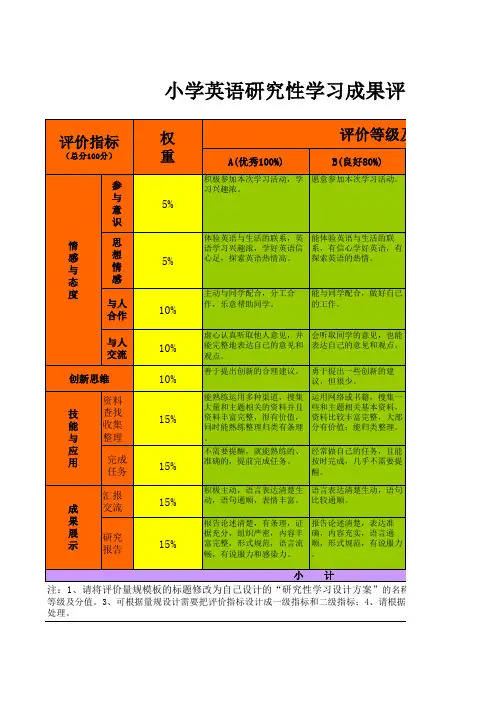
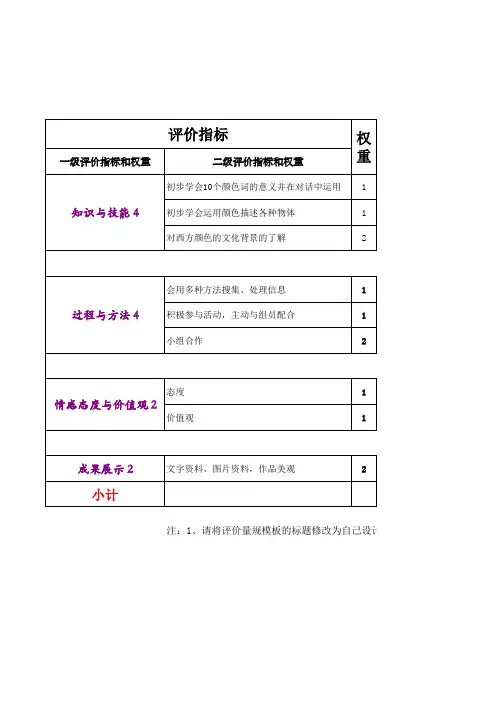
注:1、请将评价量规模板的标题修改为自己设计的“研究性学习设计方案”
情
《漫游C
设计的“研究性学习设计方案”的名称;2、结合自己的“研究性学习设计方案”,设计的相应指标、权重、等
漫游Colorful World》研究性学习成果
评价等级及分值
知识与技能得分
过程与方法得分
情感态度与价值观得分
计方案”,设计的相应指标、权重、等级及分值。
3、可根据量规设计需要把评价指标设计成一级指标和二级指标;4、请根
习成果评价量规表
值
计需要把评价指标设计成一级指标和二级指标;4、请根据实际情况明确评价量规的使用对象;5、可根据实际需要对本表进行
评价量规的使用对象;5、可根据实际需要对本表进行增删处理。

英语在线学习评价量规表
1. 学生信息
学生姓名:__________
学生年级:__________
2. 研究目标
请填写学生的研究目标,可以包括以下内容:
- 提高听力技巧
- 提高口语表达能力
- 加强阅读理解能力
- 提升写作水平
- 其他目标:__________
3. 研究进度评估(满分10分)
请根据学生的研究进度为以下项目打分,满分为10分。
学习项目评分
听力理解
口语表达
阅读理解
写作能力
4. 研究资源评估(满分10分)
请根据学生的使用程度为以下研究资源打分,满分为10分。
学习资源评分
在线课程
练习题库
学习软件
电子词典
其他资源
5. 研究态度评估(满分10分)
请根据学生的研究态度为以下项目打分,满分为10分。
学习项目评分
主动参与
积极思考
有条理安排学习时间
克服困难
6. 研究成果评估
请填写学生在以下研究项目中的成果,可以使用文字描述或者具体的数字。
- 听力理解:__________
- 口语表达:__________
- 阅读理解:__________
- 写作能力:__________
7. 研究建议
请提供对学生的研究建议,可以包括以下内容:
- 针对学生的弱项提供具体的训练方法和研究资源
- 鼓励学生利用额外的研究资源来提升自己的英语水平
- 推荐研究计划和时间管理方法
- 其他建议:__________
以上为英语在线学习评价量规表,请填写完整后提交。
谢谢!。
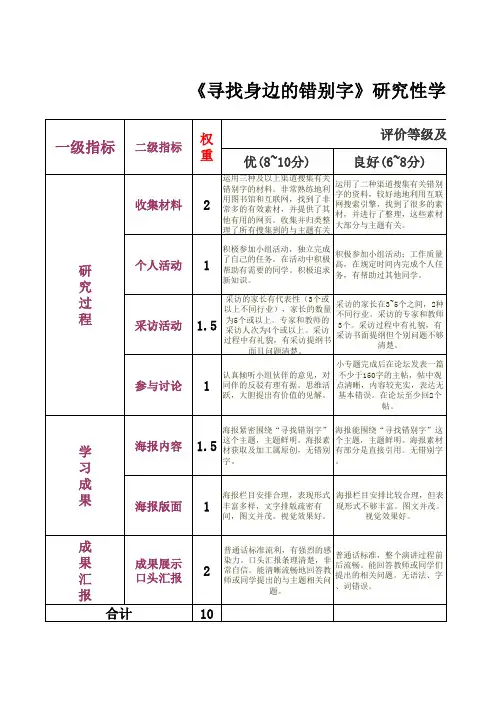
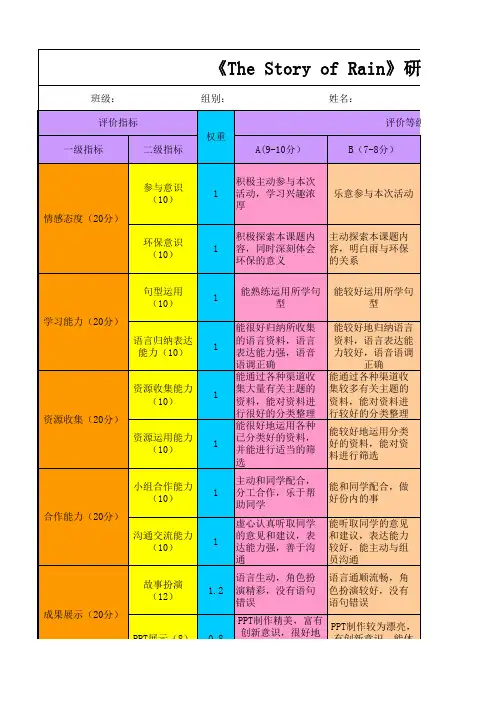
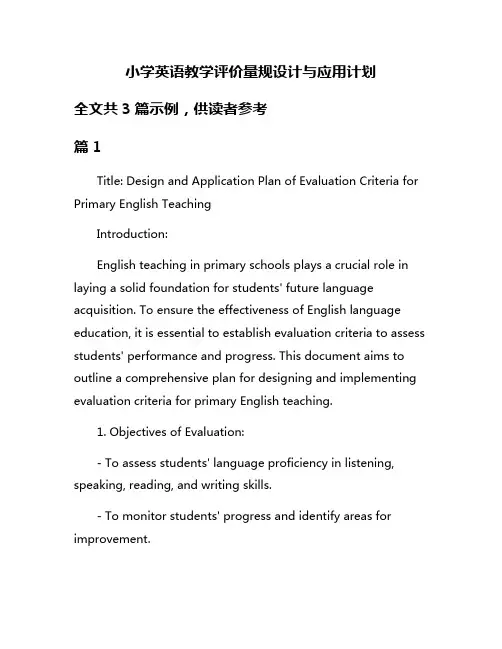
小学英语教学评价量规设计与应用计划全文共3篇示例,供读者参考篇1Title: Design and Application Plan of Evaluation Criteria for Primary English TeachingIntroduction:English teaching in primary schools plays a crucial role in laying a solid foundation for students' future language acquisition. To ensure the effectiveness of English language education, it is essential to establish evaluation criteria to assess students' performance and progress. This document aims to outline a comprehensive plan for designing and implementing evaluation criteria for primary English teaching.1. Objectives of Evaluation:- To assess students' language proficiency in listening, speaking, reading, and writing skills.- To monitor students' progress and identify areas for improvement.- To provide feedback to students, teachers, and parents on learning outcomes.- To guide curriculum development and teaching strategies.2. Design of Evaluation Criteria:- The evaluation criteria will be aligned with the primary English curriculum standards.- Different levels of proficiency will be defined for each skill area.- Rubrics and assessment tools will be developed for each skill area.- The evaluation criteria will be age-appropriate and culturally sensitive.- Both formative and summative assessment methods will be used.3. Implementation Plan:- Teachers will receive training on how to use the evaluation criteria effectively.- Evaluation criteria will be integrated into lesson planning and teaching practices.- Regular assessments will be conducted to monitor students' progress.- Evaluation results will be shared with students, teachers, and parents.- Feedback will be used to adjust teaching strategies and curriculum content.4. Benefits of Evaluation Criteria:- Provides a clear framework for assessing students' language skills.- Helps teachers identify students' strengths and weaknesses.- Encourages students to set learning goals and track their progress.- Facilitates communication between teachers, students, and parents.- Guides school administrators in evaluating the effectiveness of English language programs.Conclusion:The design and application of evaluation criteria for primary English teaching are essential for ensuring the quality of language education. By establishing clear objectives and assessment tools, teachers can effectively monitor students' progress and provide targeted support. This comprehensive plan will help to improve the overall quality of English language education in primary schools and enhance students' language proficiency.篇2Title: Design and Application Plan of Evaluation Measurement for Primary School English TeachingIntroductionEvaluation measurement plays a crucial role in assessing the effectiveness of English teaching in primary schools. It helps teachers understand the strengths and weaknesses of their teaching methods and the progress of their students. Therefore, designing an appropriate evaluation measurement plan is essential for improving the quality of English education in primary schools.Design of Evaluation MeasurementThe evaluation measurement plan for primary school English teaching should include various components to comprehensively assess the students' language proficiency and the effectiveness of teaching strategies. These components may include:1. Language Proficiency Tests: Regular assessments of students' reading, writing, listening, and speaking skills are essential to gauge their language proficiency levels. These tests can be conducted in the form of quizzes, exams, or projects.2. Classroom Observations: Observing teachers' classroom interactions, lesson delivery, and student engagement can provide valuable insights into the effectiveness of teaching strategies and student learning outcomes.3. Student Portfolios: Encouraging students to compile portfolios of their work, such as essays, projects, and presentations, can help assess their progress over time and showcase their achievements.4. Parent Feedback: Involving parents in the evaluation process by seeking their feedback on their child's English learning experience can provide additional perspectives on the effectiveness of teaching methods.Application of Evaluation MeasurementOnce the evaluation measurement plan is designed, it is essential to effectively apply it in the English teaching process. Some key strategies for applying the plan include:1. Regular Assessment: Conducting frequent assessments to track students' progress and identify areas of improvement is crucial for guiding instructional practices and scaffolding learning.2. Individualized Feedback: Providing personalized feedback to students based on their performance in assessments can help them understand their strengths and weaknesses and motivate them to improve.3. Professional Development: Offering professional development opportunities for teachers to enhance their teaching skills and incorporate new methodologies based on evaluation feedback is essential for continuous improvement.4. Data Analysis: Analyzing evaluation data to identify trends, patterns, and areas of improvement in English teaching can inform decision-making processes and drive instructional changes.ConclusionIn conclusion, designing and applying an effective evaluation measurement plan is essential for improving the quality of English teaching in primary schools. By incorporating various evaluation components and strategies into the teaching process, educators can enhance student learning outcomes and promote continuous professional growth. Thus, creating a culture of assessment and feedback is vital for fostering a conducive learning environment and achieving educational excellence in primary school English education.篇3Title: Design and Application Plan for Evaluation Quantity Standard in Primary English TeachingIntroduction:Evaluation plays a crucial role in the teaching and learning process. It helps teachers assess students' progress, identify areas of improvement, and adjust teaching strategies accordingly. In the context of primary English teaching, having a well-designed evaluation quantity standard is essential to ensure students' language proficiency development. This document aims to outline a comprehensive plan for designing andimplementing an evaluation quantity standard in primary English teaching.Designing the Evaluation Quantity Standard:1. Establishing Learning Objectives: The first step in designing an evaluation quantity standard is to define clear learning objectives. These objectives should be specific, measurable, achievable, relevant, and time-bound (SMART). For example, students should be able to demonstrate proficiency in listening, speaking, reading, and writing skills at the end of each academic year.2. Developing Assessment Tools: Once the learning objectives are established, teachers can create assessment tools to measure students' progress towards these objectives. These tools can include written tests, oral exams, project-based assessments, and performance tasks. It is important to ensure that the assessment tools align with the learning objectives and provide a comprehensive picture of students' language proficiency.3. Setting Evaluation Criteria: In order to evaluate students' performance effectively, clear evaluation criteria should be established. These criteria should outline the specific standards that students need to meet in order to demonstrate proficiencyin each language skill. For example, students may be evaluated based on their ability to understand and respond to spoken English, use appropriate vocabulary and grammar in writing, and demonstrate fluency in speaking.Implementing the Evaluation Quantity Standard:1. Monitoring Student Progress: Once the evaluation quantity standard is in place, teachers should consistently monitor students' progress towards meeting the learning objectives. This can be done through regular assessments, informal observations, and student self-assessments. By tracking students' performance over time, teachers can identify areas of improvement and provide targeted support.2. Providing Feedback: In addition to monitoring student progress, teachers should provide timely and constructive feedback to help students improve their language skills. Feedback should be specific, actionable, and focused on areas for improvement. Teachers can also involve students in the feedback process by encouraging them to reflect on their own performance and set goals for improvement.3. Adjusting Teaching Strategies: Based on the evaluation data, teachers should adjust their teaching strategies to better meet students' needs. This may involve introducing newinstructional techniques, providing additional practice opportunities, or offering individualized support to struggling students. By aligning teaching strategies with evaluation results, teachers can optimize students' language learning outcomes.Conclusion:In conclusion, designing and implementing an evaluation quantity standard in primary English teaching is essential for ensuring students' language proficiency development. By establishing clear learning objectives, developing assessment tools, setting evaluation criteria, monitoring student progress, providing feedback, and adjusting teaching strategies, teachers can effectively evaluate students' performance and support their language learning journey. With a well-designed evaluation quantity standard in place, teachers can empower students to achieve success in English language acquisition.。
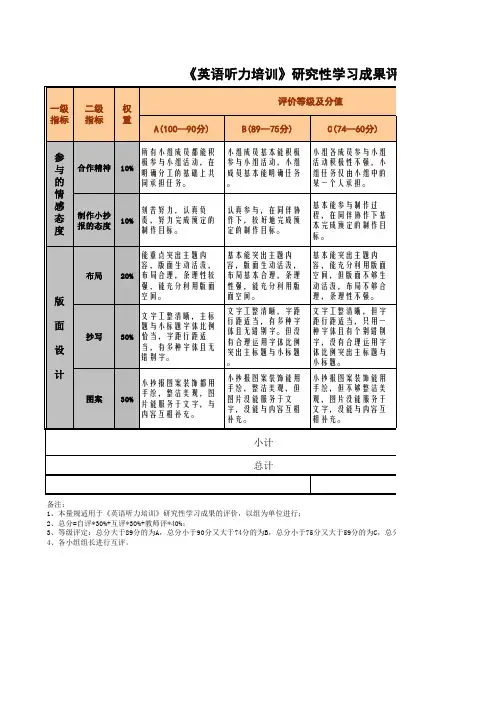

小学英语课堂评价量化表
量规应用反思
学习行为设计必须与评价量规的能力指向相一致有什么样的教学活动,就有什么样的教学成果。
我们常常试图通过期中考试、期末考试来考学生的综合能力、评价能力,但是你想想,你在教学活动中培养这些东西没有?你在教学活动当中形成这样的能力没有?所以我们现在要把能力培养植根于你的教学活动,你想培养什么能力,你就去把能力的培养嵌入到活动当中。
如果我们的教学活动大都限于知识、技能的学习层次,我们怎么能得到能力培养的结果呢?一句话,要能力之果,却只种知识之树,这怎么能行呢?我认为,本次课程培训必须实现一个观念的确立,就是:能力培养——教学活动设计与教学评价的统一。
而实现三者的统一,必须做到学习行为设计与评价量规指向的内在一致。
有了有清晰的评价量规才能有与量规指向相一致的学习行为设计。
这就是本次课程的学习反复强调评价量规的重要性。
有了清晰的评价量规,你对于目标的设计和层次才是清晰的,指向才是清楚的。
你想不到用什么办法来检测能力的时候,你的教学活动本身肯定是游离了这个目标的。
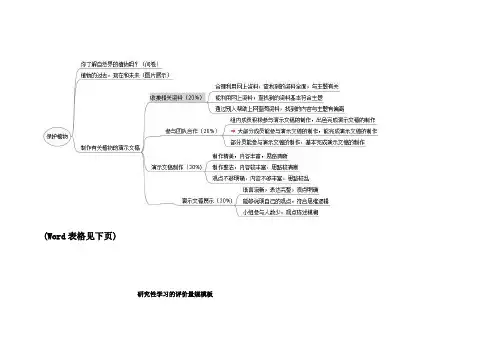
研究性学习成果评价量规评价指标权重评价等级及分值得分A(10分值) B(8分值) C(6分值) D(4分值) 自评互评教师评参与态度0.1积极参与,主动联系教师,关心小组每一项任务,并能出谋划策。
积极参与,能关心小组每一项任务。
与,听从安排。
不积极参与,对研究课题不关心。
9 9 8知识技能0.1能查阅资料,自行设计研究性学习方案,进行分析研究,并整理材料。
能查阅资料,参考别人的设计来设计研究性学习方案,并整理材料。
能查阅资料,按照别人的设计进行探究,有一定的实验能力、整理材料能力。
能查阅资料,并按照别人的设计进行探究,讨论能力、资料整理能力较差。
8 8 8创新意识0.2选题新颖、独特,研究问题方法积极、多样,活动方法灵活,能独立设计活动、开展活动。
选题新颖,研究问题方法比较多样,活动方法的比较灵活,积极参与活动。
选题基本合理,研究问题方法的比较单一,能设计简单的活动。
听从别人意见选题,研究问题方法的比较单一,活动方法不灵活性,独立设计活动、开展8 8 8活动能力不强。
解决问题能力0.2能发现问题提出问题,组织组员探究,或咨询教师、专家,制定相应的解决方案或独立解决。
发现问题提出问题,与组员共同讨论,或向教师咨询,制定相应的解决方案。
没有发现问题,积极参与小组讨论,或向教师咨询,制定相应的解决方案。
没有发现问题,不积极参与小组讨论,不能提出有效的解决方案。
8 8 7合作精神0.2与同学合作愉快,有较强的组织能力,能协调小组各个成员,有强的领导能力。
与同学合作愉快,积极配合小组工作。
与同学合作一般,基本配合小组工作。
与同学合作一般,基本配合小组工作,偶有离群现象。
9 9 9交流与评价0.1具有很强的交流意识,能正确评价自己和他人,能论述自己的探究过程和结果,并能很好地解答他人的提问,对他人的探究结果能提出较深刻的问题,并展开民主讨论.有交流的意识,对自己的探究过程和结果能大致进行解答和评价,能对他人的探究结果质疑.在交流与评价过程中叫少发表自己的观点,一般是跟随别人的观点,能简单回答他人的一些问题但不能进行解析.一般是交流与评价的旁观者,不能假说自己的探究,不能对自己和他人的探究过程和结果进行交流和评价.8 8 8完成任务情况0.1 能很好地完成各项任务。
教学设计评价量表一、英语自我介绍Hi, Good morning/afternoon everyone :My name is ….And I am from ... It is really a great honor to have this opportunity for an interview.I would like to answer whatever you may raise, and I hope I can make a good performance today .Now let me introduce myself briefly.I am … years old . I graduated from … University in … . And then I got a higher degree in… university in…. I have worked for... years since I graduated from the university .And I have been a head teacher for … years .Being a teacher is tired but excited. Having taught for so many years, I think I am experienced in teaching field. I have ever got much honor in teaching, but still I think I need a new environment to challenge myself.I am open—minded, quickly thoughts and skillful in searching for information on internet . I can operate computer well . In my spare time, I have broad interests .Such as reading ,surfing the internet ,enjoying music ,writing some articles on my blog and even chatting with foreign friends online if possible .I always believe working hard can bring us more opportunities . To be the best one is a little bit hard. But “Trying All My Best “ always can cheer me up .To succeed or fail is not the only thing . It’s in how we face and invaluate ourselves .This is the chance we take, and this is what we've worked fo r all our lives . Shining like a shooting star at night, and always smile at life .We’ve got to give it all . Someday when we turn back for what the footprint we have left , time will record the victory in our heart . So “ Try All My Best ” --- this is the motto of mine .Ok !So much .Thank you!二、可能问的问题你教了几年书?How long have you been teaching?I have been teaching for...有教小学的经验吗?Did you have any experiences teaching in elementary school/primary school?Y es, I did. or No, I didn’t.你打算怎么样给小孩上课?How are you going to give lessons to little kids?I think I am going to use all kinds of materials that are available like CD player, pictures, word cards, TV, magazines, games acts in my lessons. I am going to use different teaching methods to help children with different learning styles.能否示范一下?Can you demonstrate one lesson?Sure. If I teach days of the week, I will teach children a song: Sunday, Monday...(用twinkle twinkle little star 的tune)你觉得教小学生跟教中学生有什么不同?What is the difference between teaching elementary school children and the junior high school children?well, when teaching little kids a teacher has to be more patient. He/she has to use lots of songs, games, body language to help student learn English. The forms of each lesson should be different.Teaching junior high school kids is a little bit different. I can introduce some grammar. I can give them more written work and I can have more discussions with the children.如何让小学生对英文感兴趣?How are you going to keep the students interested in learning English?如何将你的课上得有趣?How are you going to keep your lessons interesting?这两道题的答案是一样的,只不过问的形式不一样.I will try my best to use all the teaching methodologies I learned at school to reach each child. Stories, poems, riddles, jokes songs are all good for little kids. I will have them practice English as a whole class, group work, pair work or independent work. Whatever works out for the children I will do it. There is never one way to success。
小学英语形成性评价_小学英语形成性评价试验研究成果汇报小学英语形成性评价试验研究成果汇报(一)英语实验形成性评价计划( 20__/9 )根据课程标准形成性评价的理论指导,形成性评价是教学的重要组成部分和推动因素。
形成性评价的任务是对学生日常学习过程中的表现、所取得的成绩以及所反映出的情感、态度、策略等方面的发展做出评价。
其目的是激励学生学习,帮助学生有效调控自己的学习过程,使学生获得成就感,增强自信心,培养合作精神。
形成性评价有利于学生从被动接受评价转变为评价的主体和积极参与者。
为了使评价有机地融入教学过程,应建立开放、宽松的评价氛围,以测试和非测试的方式以及个人与小组结合的方式进行评价,鼓励学生、同伴、教师和家长共同参与评价,实现评价主体的多元化。
形成性评价的形式可有多种,如课堂学习活动评比、学习效果自评、学习档案、问卷调查、访谈、家长对学生学习情况的反馈与评价、平时测验等。
形成性评价可采用描述性评价、等级评定或评分等评价记录方式。
无论何种方式,都应注意评价的正面鼓励和激励作用。
教师要根据评价结果与学生进行不同形式的交流,充分肯定学生的进步,鼓励学生自我反思、自我提高。
(二)根据试验的指导思想,本项目的基本设想由以下几点构成:1、初步了解学生对英语的掌握情况。
2、指导学生根据自身实际情况拟定阶段性学习目标。
3、在完成一个阶段后,指导学生通过自评,互评,家长评,老师评几种方式来进行阶段性评价小结。
4、指导学生收集一些能够体现自己英语学习成果的材料,装入档案袋,以便更加促进学生学习英语的兴趣。
(三)进度安排:第一阶段(四年级上期):初步了解。
调查了解试验班学生掌握英语情况,指导学生拟定阶段性学习目标。
第二阶段(四年级下期、五年级):课题展开。
充分调动学生的学习积极性,师生以及家长互相配合,促进学生全面发展。
指导学生收集各种英语作品,装入档案袋。
指导学生进行阶段性小结。
第三阶段(六年级):成果展示。